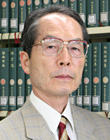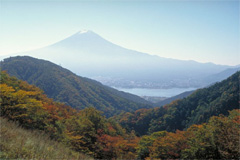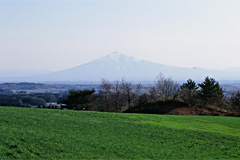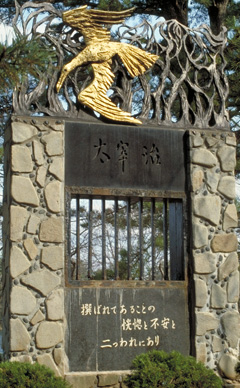Top>Research>Osamu Dazai and the beauty of his literature
 Index
Index

Yoshinori Watabe [Profile]
Education Course
Osamu Dazai and the beauty of his literature
Yoshinori Watabe
Professor of Modern Literature, Faculty of Letters, Chuo University
The basic stance of Dazai the writer
The basic stance of Dazai the writer was to be a writer like a "street musician" (Kamome (The Seagull) and Zenzo wo Omou (Think about Zenzo)) who gets passers-by, readers, to enjoy the happiness of a modest heart like "the gift of a single dandelion" (Hazakura to Mateki (Young Cherry Leafs and Magic Flute)).
<The King of Hearts>

Dazai Museum, house of his birth: Shayokan (Photos by Yoshinori Watabe)
Dazai was born into the fourth wealthiest family in Aomori, Dazai, who never felt true happiness while being raised on material wealth, gradually began to think that true happiness lies in the heart rather than in material happiness, and sought that pleasure in literature.
In Kokoro no Oja (The King of Hearts), which was published in Keio University's Mita Newspaper, he calls on students to be "kings of hearts" in a parody of the phrase "king of the land, Keio" from Keio's cheerleading song. Rather than being "king of the land" who reaches the summit of prosperity and power, be "king of hearts" who gives first place to inner happiness.
It was with that basic posture that he created jewels of works overflowing with touches of human kindness such as Ougon no Fukei (Golden Landscape), I Can Speak, Shinju no Kotoba (Words of Newly Green Trees), and Aruto Haideruberuhi (Heideruberuhi Old).
Kindness in Dazai's literature
(Dazai says in his novel Tsugaru that his "major subjects" are "subjects" called "love", which is the research into "human heart and contact with the human heart". Where does the kindness in Dazai literature come from? That comes from the "realization of sin" in the roots of Dazai literature.
Nonaka, a character in his postwar work Haru no Kareha (Dried Leaves of Spring), says the following.
The Bible says, "he who is forgiven little, loves little." Do you know what this means? Only those who are confident that they have made no mistakes in life are heartless. Those who are sinful have deep affection.
This doesn't mean that anyone who has many crimes will become a person with deep affection. Those who sin and have a deep realization of their sinfulness become modest, kind, and deeply affectionate people.
Dazai felt ashamed of being a member of a bourgeois household. Despite being engaged to one woman, he was involved in the suicide of another woman he had feelings for (November 1930), and on entering university, he was briefly involved in a leftist movement, but left after betraying some friends (Summer 1932). In these ways Dazai had betrayed and hurt people and piled up his sins. But inside, Dazai had a deep realization that he was bad and was a man of extreme crime. That is the foundation of the kindness of Dazai and Dazai literature.
Many works of literature full of "love" and "kindness" were created in his middle period, from 1939 to 1945.

Mt. Fuji as seen from the Misaka Pass, the setting of Fugaku Hyakkei (One Hundred Views of Mt. Fuji) (Photos by Yoshinori Watabe)
In this period Dazai repeated in his works, the words "plain" and "simple"(Ai to Bi ni Tsuite (For Love and Beauty), Kashoku (Marriage)),"honest"(Tousen no Hi (Day of Election), Shoujiki No-to (Honest Note)), "I want to become natural. I want to become sincere."(Joseito (Schoolgirl)), and "simple, natural things are accordingly concise and clear."(Fugaku Hyakkei(One Hundred Views of Mt. Fuji)). These are the things Dazai longed for at the time.
These intentions of Dazai is summarized in the following message, which is said to be the words that Dazai told his apprentice, Hidezumi Katsura, in 1942.
Basho stated wabi-sabi (impermanence) and spirit. At the end he mentioned "lightness". The direction a new art follows lies in this lightness. In Kendo, it is like delivering a clean hit to the forearm without exerting any strength. It's that feeling, anguish sinks to the bottom and you feel clear.(omission)In music, it is probably Mozart.(The words of Osamu Dazai, Hidezumi Katsura, Hakone no Dazai (Dazai at Hakone) )
This ideology of "lightness", which was nurtured from 1939 to 1945, bloomed and came to fruition in the postwar Pandora no Hako (Gap of Pandora). Youths, the main character facing the new postwar era says as follows.
A new era has truly come. It is as light as a robe of feathers, and furthermore, as limpid (note: crystal-clear and cold) as a stream flowing over white sand.
Light and pure poems are, (omission) like Mozart's music for example, a cheerful art with noble clarity. That is what we desire at the moment.
This "lightness" is different to insincerity. If you don't discard desire and life, you won't understand the mind. (omission) The peace lying in those who lose everything, who throw away everything, is that "lightness". (Pandora no Hako (Gap of Pandora))
In Gap of Pandora, Dazai declares "peace in those who lose everything, who throw away everything", "give up everything and throw it away" and "honesty", "simple", "cold and clear" minds and a "light" spirit as ideal.
This healthy and bright Dazai and that literature will have many people sense a difference from the image Osamu Dazai they have embraced. But, in close to three quarters of Osamu Dazai's 16 years as a writer, he has written many bright and healthy ambitious pieces.
A view of Dazai Literature(What is literature?)

Dazai Literature Monument at Kanita: "More than anything, he enjoyed making people happy!!" (Photos by Yoshinori Watabe)
As expressed in the following, to Osamu Dazai, literature was basically something for readers to enjoy, a pastime, something pleasing, and something to bring joy to the heart. "My art is no different from the beauty possessed by a toy" (Mono no Omou Ashi〔Sono Ichi〕 (Meditating Reed Grass (Part 1)), "kind, sad, strange and noble, what more do you need to be?"(Bannen ni Tsuite (Later Years) ), "What should one do with this beautiful box decorated with assorted figured paper? Nothing. Isn't it beautiful as it is?"(Hashiranu Meiba (A Fine Horse That Doesn't Run)), "The beauty of art is, when all said and done, the service of beauty for the people."(Gyakko (Retrogression)), "More than anything, he enjoyed making people happy!"(Seigi to Bisyou (Smile and Justice) ), "Japanese literature (omission) is far from becoming humoresque. (omission) It doesn't know how to enjoy idly. It blindly enjoys seriousness. It doesn't know the beauty of nonsense."(Koten Ryuto-dabi (The Anticlimax of the Classics)), and "The most important thing in literature is 'affection'."(Nyoze Gamon (I Heard it in this Way)).
Unintelligible (dandyism)・Decline(decadence)
Despite writing many enjoyable, bright and healthy works, he was unable to shed his unintelligible, decadent and unhealthy dark image through that literature due to dandyism in his early writing and a strong image of decadence and unconventionality in his later years.
In Dazai's early years (1933-1937), especially from 1935 to the beginning of 1937, he adopted a method called dandyism and displayed an extremely difficult to follow literary style. Influenced by Baudelaire dandyism, he over-decorated his writing and lifestyle as people dress up. He thought that being gaudy and fashionable was a writer's way of showing "affection" to his readers.
He shows a highly artificial world in saying "If it isn't art which is intellectual and hacked to pieces, it isn't interesting."(Dasu Gemaine (Das Gemeine)), "manmade beauty"(Mono no Omou Ashi〔Sono Ichi〕 (Meditating Reed Grass (Part 1)), and "manmade zenith"(Fabricated Spring). Through that impression of a writer's efforts, he tried to display the sincerity of a writer.

Mt. Iwaki from Dazai's hometown of Kanagi (Photos by Yoshinori Watabe)
Symbolic of this dandyism style are the words "Even if we are certain to die, use sweet words with feigned sincerity!"(Mono no Omou Ashi〔Sono Ichi〕 (Meditating Reed Grass (Part 1)). Confucius took sweet words with feigned sincerity as a lack of virtue, but Dazai took it as "affection". He displayed a writer's love to his readers with ingenious works and language while living a garish life. He intentionally wrote in a difficult to understand style, staging confusion and playing the villain.
Through that difficult style, his innovative language invited misinterpretation and he missed out on the first Akutagawa Prize. He then became addicted to Pavinal, and after being taken in by seniors and friend's family members, he was admitted to hospital.
Even with such works where unintelligible dandyism was freely used, the writer would intentionally write in a difficult style using unique expressions. It was there that I thought Dazai tried showing individuality, novelty and sincerity, and it proved to be surprisingly interesting reading. You can enjoy the magical world of sparkling language.
Strong anticonventional spirit after the war (from 1946 to June 1948)

Dazai Literature Monument (Photos by Yoshinori Watabe)
When Dazai returned to Tokyo after evacuation, he was unable to hold himself back when he saw intellectuals depart the same leftist movement and cooperate with policies differing from their wartime policies, jumping on the wave of postwar democracy without hesitation. They had showed no remorse or sense of sin in committing the shameful act of converting and conforming to national policy. By realizing his own wrong-doings, surely he was a better person than that crowd. The strong anticonventional spirit he held for one and a half years of his latter years was created from that kind of self confidence. He strongly criticized culture snobs of the world. But, paradoxically, he took up a form of decadence for criticizing them and condemned. That figure left an extremely deep impression on his readers, leading to the image of Dazai seen by the general public.
I want you to know not just a part of Dazai, but Dazai in general. In his younger years, he adopted dandyism and was difficult to follow, but he painted an individual and peculiar world of manmade beauty. In midlife, by realizing his sins, he was modest and kind, writing about a world of human love in a bright and healthy style full of humor. I would like you to pick up one of Dazai's works with that bright flavor.
Conclusion
The 20th century was a century devoted to craftsmanship. The 21st century will be a century aiming to recapture happiness in the heart which was forgotten through that craftsmanship. Dazai, who gave his readers small comforts like "a single dandelion", who wished to be an artist like a "street musician", who treasured happiness of the heart over material happiness, who was the "King of hearts", preempted the 21st century's age of the happy heart.
Yoshinori Watabe Research Profile(PDF File)![]()
- Click here to see Chi no Kairo (The Corridor of Wisdom), the educational program supervised by the author (Visiting the Hometown of Kenji Miyazawa, Program 11)

- Click here to see Chi no Kairo (The Corridor of Wisdom), the educational program supervised by the author (The King of Hearts: Taking a Walk through Osamu Dazai's "Tsugaru," Part 1, Program 18)

- Click here to see Chi no Kairo (The Corridor of Wisdom), the educational program supervised by the author (The King of Hearts: Taking a Walk through Osamu Dazai's "Tsugaru," Part 2, Program 19)

- Click here to see Chi no Kairo (The Corridor of Wisdom), the educational program supervised by the author (Literary Walk in Matsuyama, Part1: Soseki Natsume, Program 35)

- Click here to see Chi no Kairo (The Corridor of Wisdom), the educational program supervised by the author (Literary Walk in Matsuyama, Part2: Shiki Masaoka, Program 36)

- Click here to see Chi no Kairo (The Corridor of Wisdom), the educational program supervised by the author (Passion for the Darkness: The World of Motojiro Kajii, Program 44)

- Click here to see Chi no Kairo (The Corridor of Wisdom), the educational program supervised by the author (Taking a Walk through Onomichi: The Roots of Fumiko Hayashi's Love Story, Program 59)

- Click here to see Chi no Kairo (The Corridor of Wisdom), the educational program supervised by the author (Naoya Shiga: The Way from Conflict to Harmony, Program 60)

- Yoshinori Watabe
Professor of Modern Literature, Faculty of Letters, Chuo University - Born in Yotsuya in Shinjuku, Tokyo in 1940. Raised in Machida. Attended Machida Elementary School and Nerima Kaishin First Primary School before entering the Japanese Literature Department at the Faculty of Letters, Tokyo University from the University of Education Junior and Senior High Schools. After leaving graduate school, he worked at Musashi Junior and Senior High Schools and Rissho University before taking up his current post in the Faculty of Letters, Chuo University in 1976. During this time he has also worked as a lecturer at Aoyama Gakuin Women's Junior College, Gakushuin Women's Junior College, and University of the Sacred Heart, Tokyo. He has an interest and is conducting research in modern literature and modern poets such as Motojiro Kajii, Kojiro Serizawa, Sakutaro Hagiwara, and especially Osamu Dazai and Kenji Miyazawa. Watabe likes photography and cars, and travels around Japan searching for natural features related to modern writers.
- Research Activities as a Member of Research Fellowship for Young Scientists (DC1), Japan Society for the Promotion of Science (JSPS) Shuma Tsurumi
- Important Factors for Innovation in Payment Services Nobuhiko Sugiura
- Beyond the Concepts of Fellow Citizens and Foreigners— To Achieve SDGs Goal 10 “Reduce Inequality Within and Among Countries” Rika Lee
- Diary of Struggles in Cambodia Fumie Fukuoka
- How Can We Measure Learning Ability?
—Analysis of a Competency Self-Assessment Questionnaire— Yu Saito / Yoko Neha - The Making of the Movie Kirakira Megane








